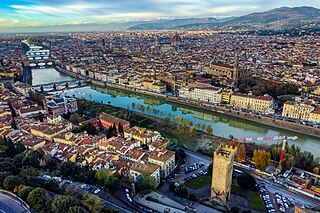
The Arno is a river in the Tuscany region of Italy. It is the most important river of central Italy after the Tiber.

The river Ticino is the most important perennial left-bank tributary of the Po. It has given its name to the Swiss canton through which its upper portion flows.

Lake Titicaca is a large freshwater lake in the Andes mountains on the border of Bolivia and Peru. It is often called the highest navigable lake in the world. Titicaca is the second largest lake in South America, both in terms of the volume of water and surface area. It has a surface elevation of 3,812 m (12,507 ft).

Lake Lugano is a glacial lake which is situated on the border between southern Switzerland and northern Italy. The lake, named after the city of Lugano, is situated between Lake Como and Lago Maggiore. It was cited for the first time by Gregory of Tours in 590 with the name Ceresio, a name which is said to have derived from the Latin word cerasus, meaning cherry, and refers to the abundance of cherry trees which at one time adorned the shores of the lake. The lake appears in documents in 804 under the name Laco Luanasco.

Los Lagos Region is one of Chile's 16 regions, which are first order administrative divisions, and comprises four provinces: Chiloé, Llanquihue, Osorno and Palena. The region contains the country's second-largest island, Chiloé, and the second-largest lake, Llanquihue. Its capital is Puerto Montt; other important cities include Osorno, Castro, Ancud, and Puerto Varas. Los Lagos Region is considered part of Patagonia.

Lake Texcoco was a natural lake within the Anahuac or Valley of Mexico. Lake Texcoco is best known for an island situated on the western side of the lake where the Mexica built the city of Mēxihco Tenōchtitlan, which would later become the capital of the Aztec Empire. After the Spanish conquest, efforts to control flooding led to most of the lake being drained.

The province of Brescia is a province in the Lombardy region of Italy. It has a population of some 1,265,964 and its capital is the city of Brescia.

Calvagese della Riviera is one of the 206 municipalities of the Province of Brescia, in the northern Italian region of Lombardy. It is some 10 kilometres (6 mi) west of Lake Garda. Its population of 3,522 is divided between the centres of Calvagese itself, Carzago, and Mocasina. Other localities include Belvedere, Ponte Clisi, and Terzago.

Juscelino Kubitschek Bridge, commonly called Ponte JK, is a steel and concrete arch bridge across Lake Paranoá in Brasília, Brazil. It connects the eastern shore of the lake – where Lago Sul, Paranoá and Brasília International Airport are located – to Brasília's city center, via the Monumental Axis. Opened to traffic on December 15, 2002, its distinctive silhouette quickly became a Brasília landmark.

Val Camonica or Valcamonica, also Valle Camonica and anglicized as Camonica Valley, is one of the largest valleys of the central Alps, in eastern Lombardy, Italy. It extends about 90 kilometres (56 mi) from the Tonale Pass to Corna Trentapassi, in the commune of Pisogne near Lake Iseo. It has an area of about 1,335 km2 (515 sq mi) and 118,323 inhabitants. The River Oglio runs through its full length, rising at Ponte di Legno and flowing into Lake Iseo between Pisogne and Costa Volpino.

Omegna is a comune (municipality) in the Province of Verbano-Cusio-Ossola in the Italian region Piedmont, located about 100 kilometers (62 mi) northeast of Turin and about 13 kilometers (8 mi) southwest of Verbania at the northernmost point of Lago d’Orta and traversed by the Nigoglia, the lake's sole outflow.

Lake Ranco is situated in the Ranco Province of Los Lagos Region in Chile. Covering an area of 442 km2, it is the largest lake in the Los Ríos Region and the fourth largest in Chile. It has approximately 25 islands and islets, but only 4 are currently inhabited.

Puyehue Lake, is an Andean piedmont lake on the border of Los Lagos Region with Los Ríos Region of Chile.

The Lakes of Covadonga (el. 1134 m.) are composed of two glacial lakes located on the region of Asturias, Spain. These lakes, often also called Lakes of Enol or simply Los Lagos, are Lake Enol and Lake Ercina located in the Picos de Europa range and they are the original center of the Picos de Europa National Park, created in 1918. They are near the Covadonga Sanctuary.

Lake Idro is an Italian prealpine lake of glacial origin situated largely within the Province of Brescia (Lombardy) and in part in Trentino.

The Nam Van Lake is a man-made lake in Sé, Macau. It is one of two man made lakes in Macau. It is located at the southern end of Macau Peninsula.

The Lago di Santa Croce is a semi-natural lake in the province of Belluno, Veneto, northern Italy. It is part of the communes of Alpago and Ponte nelle Alpi.

The Società Navigazione del Lago di Lugano or Lake Lugano Navigation Company (SNL) is a Swiss company operating passenger services on Lake Lugano. The company also operates bus routes in the same area, and is based at Cassarate in the city of Lugano. It was formerly known as the Società di Navigazione e Ferrovie per lago di Lugano and at one time also operated railways in the area.

The Menaggio–Porlezza railway was a railway in the Italian province of Como. The line connected the town of Menaggio, on Lake Como, with Porlezza, on Lake Lugano, and was built as part of a multi-modal transport link between Menaggio and Luino, on Lake Maggiore.

The Portuguese Way is the name of the Camino de Santiago pilgrimage routes starting in Portugal. It begins at Porto or Lisbon. From Porto, along the Douro River, pilgrims travel north crossing the five main rivers—the Ave, Cávado, Neiva, Lima and Minho—before entering Spain and passing through Pontevedra on the way to Santiago de Compostela.























